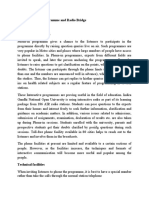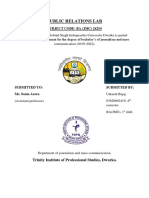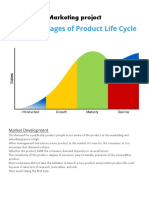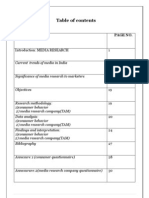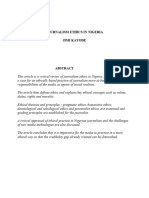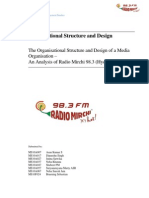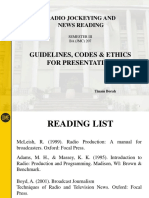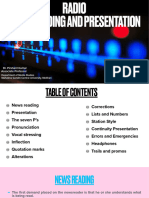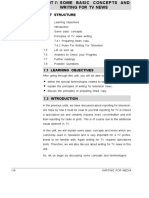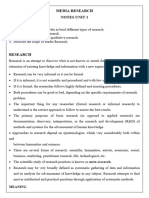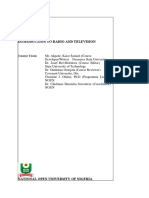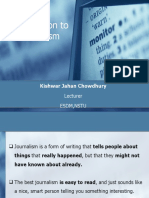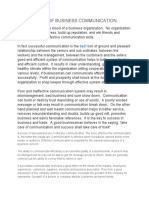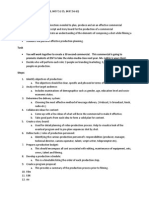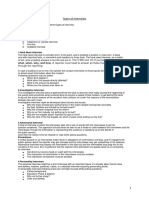TRINITY INSTITUTE
OF
PROFESSIONAL STUDIES
Sector-9, Dwarka, New Delhi-110075
(Affiliated to Guru Gobind Singh Indraprastha University, Delhi & Approved by Bar Council of India, New Delhi)
“A+” Ranked Institution by SFRC, Govt. of NCT of Delhi
Recognized under section 2(f) of the UGC Act, 1956
Accredited “B++” by NAAC
LAB MANUAL
RADIO PRODUCTIO LAB
COURSE CODE:256
NAME................................................
ENROLLMENT NO. ..........................
CLASS................................................
1
�OBJECTIVE OF THIS COURSE:
On Completion of this course, the student should be able to
• distinguish and differentiate between various radio programme formats
• demonstrate proficiency of skills in production of a radio programme
OBJECTIVE OF THIS MANUAL:
This Lab Manual is intended to be used by students of BA (JMC), Semester
3rd for RadioProduction.
The Radio Production Lab Manual covers topics that are essential for the
students tostrengthen their theoretical concepts. The purpose of this
manual is to give guidance and instructions to the students regarding this
subject.
HOW TO USE THIS MANUAL
Use of this manual is mandatory for the completion of practical. It
provides the students with the firsthand knowledge of the practical
subjects. It also makes them learn a systematic approach to do their
task proficiently as per the need and requirement of the industry.
INSTRUCTION TO THE STUDENTS
1. Students are REQUIRED to carry this manual during the Lab Class.
2. Students are REQUIRED to read the topics mentioned before
coming to theLab Class.
3. Students are REQUIRED to follow the timeline for each assignment.
2
� Table of Contents
S.No TOPIC PAGE NO. SIGNATURE
1. Radio Programme Formats
2. Work on studio recording
3. Vox-Pop/Interview
4. Prepare a production book
5. public service announcement/
radio commercial
6. Radio news/documentary/
feature/drama/interview/discussion
3
� Topic-1
Radio Programme Formats
Radio formats are like templates for the overall content a radio station
broadcasts. Most commercial stations in the radio industry fit into formats
defined by content that appeals to specific audiences. That content might be a
style of music, or it might be news, sports, or other programming. As a
medium, radio developed radio formats to compete with television's rise in
popularity. The different formats each focused on the preferences of a
particular demographic, allowing them to tune in according to taste. Over
time, the formats were tailored further to appeal to specific audiences. By
clearly defining a format, radio stations are able to build their media brand
and sell advertising based on the expected demographics of the listeners.
[Programme Formats]
1. Radio Announcement and Links
2. Radio Talk
3. Radio Interview and Discussion
4. Radio News
5. Radio Feature and Documentary
6. Radio Commentary
7. Radio Play/Drama
8. Radio Ads (Social and Commercial)
9. Phone-in and Radio Bridge
4
�LAB EXERCISE/ASSIGNMENT 1: VARIOUS RADIO PROGRAMME
FORMATS
Describe in details about Various Radio Programme Formats.
5
�Topic 2
WORK ON STUDIO RECORDING AND EDIT USING DIGITAL AUDIO EQUIPMENT
SUMMARY OF KEY CONCEPTS
Creating a music studio, in a formal space or in your home/office, is an
exciting endeavor. Whether you’re recording for other artists or creating a
personal studio for your own music or spoken word projects, making a
creative space in which to produce music and other types of audio is a little
akin to making a long-distance trek into a wondrous and inspiring landscape,
with limitless possibilities for adventure and exploration.
All studios use similar sets of equipment, albeit some without the bells and
whistles that make up some larger studios. While it can be a little confusing
for the beginning audio producer to assemble a studio, there are a few
essential pieces of equipment that will ensure they get off to a smooth start,
even on a tight budget.
METHOD AND APPROACH
Here’s a comprehensive list of basic equipment found in a recording studio.
There will be a laptop or desktop computer, digital audio workstation,
microphones, stands, mixing board, sound baffles, DJ and mixing
headphones, studio speakers and instruments.
And for a setup like this, you need the following 9 items:
a. Computer
b. DAW
c. Audio Interface
d. Microphones
e. Headphones
f. Studio Monitors
g. Cables
h. Microphone Stands
i. Pop Filter
6
�The Core Concept of Digital Audio Recording:
7
�LAB EXERCISE/ASSIGNMENT 2
Describe the Core Concept of Digital Audio Recording.
8
�LAB TOPIC–3
WORK ON OUTDOOR RECORDINGS: VOX-POP/INTERVIEW
SUMMARY OF KEY CONCEPTS
The term ‘vox pop’ originated from the Latin phrase Vox Populi, which means
‘voice of the people for those of us who didn’t benefit from a classical
education’.
Today, a vox pop is a short video made up of clips taken from interviews with
members of the public. These video interviews investigate public opinion
towards widely known topics, brands or products and are commonly used
for market research.
A distinct feature of vox pops videos is the setting for where the interviews
take place.
METHOD AND APPROACH
Here are some tips on recording vox pop to ensure a useful and clear
transcript:
• Think about the location – it could be the street or a university corridor.
Some background noise, such as traffic, will make it authentic but the sounds
should not be too loud as this will make it difficult for the transcriptionist to
hear what is being has said.
• An interesting vox pop will include a mix of male and female voices of
different ages and accents. If your vox pop subject is a controversial one, try
to get opinions from people with varying views. Interview at least 10 persons.
• Don’t ask a question that will result in a ‘yes’ and ‘no’ response.
• Keep your recording machine in RECORD/ PAUSE mode. After you record
yourself asking the question, put the machine in PAUSE mode whenever you
ask the question again. When the person answers, switch to RECORD mode.
This method will ensure that you won’t have to edit the question several
times.
However, using recording equipment with this bleep option may reduce the
accuracy of transcripts as it would obscure the voice of the speaker.
9
�SAMPLES
Example1. After asking ordinary people on the streets of BIGTOWN how they
feel about the building of the new pharmaceuticals factory, you use the
answers to put together a vox pop. Afterwards, when you conduct your
studio interview with the mayor, you confront him with what the people said
and refer to the vox pop in your first question: “Mr. Mayor, you have heard
some of the residents’ opinions. How do you feel about these?”
Example2. You have a report in your programme about the press conference,
in which the
Mayor and the pharmaceuticals plant PILLCO announced that the new
factory would be built. In this report, the listeners find out what the officials
have to say on this topic. But they do not know what the residents of the
affected neighbourhood BIGTOWN think about the plans. Do they all agree
with the project? Are there also critical voices? Or are the people indifferent
about what is happening?
Of course you could summarize in your own words that opinion about this
project is divided, that there are both positive and negative views among the
population. But this way of presenting that information would be rather
boring and not at all “radiophonic”. It would be better to give the affected
people a voice in your programme: let the listeners hear what the people say
in a vox pop, which you can broadcast after the report. That way, the
listeners get all the information on the various parties’ opinions – and it is
been presented in a very authentic and lively manner.
Vox pops are an instrument to present public opinion on the radio, and help
make your programmes sound more dynamic. As the people voice their
opinions spontaneously, they are often emotional, angry, funny or provide
unexpected insights. The voices of average people lend your programmes
more authenticity and credibility. Listeners can identify with the people they
hear on the radio. After all, these are not politicians or experts who “talk
down to them”, but ordinary people – just like them.
10
�LAB EXERCISE / ASSIGNMENT3: VOX-POP/INTERVIEW
How to make a Vox-Pop Interview? Explain with example.
11
�LAB TOPIC–4
PREPARE A PRODUCTION BOOK
SUMMARY OF KEY CONCEPTS
The process of producing an audiobook is a detailed and extensive process
from start to finish. It starts with the production of the script text. Producers
then assign a narrator for the recording and finally edit the audio into a
cohesive audiobook.
Production services of an audiobook consist of:
• Text preparation
• Voice narrator casting
• Voice recording
• Audio editing
• Proofing
• Audio mastering
• Distribution
METHOD AND APPROACH
An audiobook recording is often done in a soundproof booth in a recording
studio environment. The recording has to be clear of background noise since
the final product will be primarily voice-focused. This is normally
accomplished in a quite soundproofed facility designed for voice recording.
Prepare a production book including:
a. Audio brief
b. Program objective (s)
c. Synopsis
d. Treatment
e. Script
f. Crew list
g. Technical requirements
h. Budget
12
�LAB EXERCISE / ASSIGNMENT4: PREPARE A PRODUCTION BOOK
How to prepare a production book? Explain with synopsis and budget.
13
�LAB TOPIC–5
PUBLIC SERVICE ANNOUNCEMENT/RADIO COMMERCIAL
SUMMARY OF KEY CONCEPTS
A public service announcement (PSA) is a short, community-oriented
message that radio stations air at no cost in order to fulfill their obligation to
serve the public interest. PSAs are a cost-effective way for non-profit
organizations to raise awareness about the benefits their organizations
provide. Radio stations receive PSAs as audio files – typically recorded as :30
or :60-second messages. These files can be accompanied by scripts for
announcers to read live on air. Through appropriate distribution, they can be
targeted to preferred demographics and markets.
Radio advertising is buying commercials to promote products or services.
Advertisers pay commercial radio stations for airtime and, in exchange, the
radio station broadcasts the advertiser's commercial to its listening
audience.
METHOD AND APPROACH
There are four major types of radio advertising, namely, straight
commercials, dialogue commercials, dramatized commercials and integrated
commercials.
Create The Perfect Ad. Every great ad starts with great script. There are 3
basic elements to any radio ad – the script, the casting, and the production.
What are 3 elements of a PSA?
Here are 3 factors to take into account when thinking about creating a PSA:
• Clear Messaging. Single Message. ...
• Clear Target Audience. Once you've identified your messaging and topic,
you now need to package it in a way that is relevant to your target audience.
...
• Focus on Emotion not fear
14
�SAMPLE: 5
This is a 30 second PSA script on vaccinations from the Illinois State Medical
Society:
In healthcare, misinformation can be as deadly as the most serious disease –
and spread just as quickly. For years now, myths about childhood
immunizations have been spreading on the Internet and social media. The
physicians of the Illinois State Medical Society urge parents to know the facts
and get your children immunized. Immunizations are scientifically proven to
be safe and effective, and failure to immunize can harm your children and
others. Talk to your child’s doctor to get the facts about immunizations.
This next 30 second PSA example from the Leukemia Research Foundation
announces an upcoming conference, encouraging people to attend:
If you or a loved one is living with leukemia, lymphoma, multiple myeloma,
or MDS, don’t miss the 15th annual Treatment Options for Blood Cancer
Patients conference on Saturday morning, May 11, at the Hyatt Regency in
Lisle. You’ll learn about the latest breakthroughs and emerging treatments
presented by leading experts in the field. The free Treatment Options
Conference is presented by the Leukemia Research Foundation and includes
breakfast and lunch. For more information, registration, and a full program
agenda visit all-blood-cancers-dot-org.
15
�LAB EXERCISE / ASSIGNMENT 5: PUBLIC SERVICE ANNOUNCEMENT/RADIO
COMMERCIAL
write a radio public service announcement/Radio Commercial.
16
�LAB TOPIC–6
RADIO NEWS/DOCUMENTARY / FEATURE/ DRAMA
/INTERVIEW/DISCUSSION
SUMMARY OF KEY CONCEPTS
Radio drama: A Radio drama or a radio play is like any other play staged in a
theatre or a hall. The only difference is that while a stage play has actors,
stage, sets, curtains, properties movement and live action, a radio play has
only 3 components. They are the human voice, music and sound effects.
Radio of course uses its greatest strength for producing radio plays and that
is the power of imagination and suggestivity.
If you see a film in a movie hall, it is generally a feature film, which is story
based and not real. But there are also documentary films which are based on
real people and issues. A lot of programmes you see on television are
educational and public service documentaries
Among all the spoken word formats on radio, news is the most popular. News
bulletins and news programmes are broadcast every hour by radio stations.
In India, only All India Radio is allowed to broadcast news.
Radio interviews: Have you ever interviewed anyone? Probably yes. In the
media, be it the newspaper, magazine, radio or television, journalists use this
technique of asking questions to get information.
Radio discussions: - When you have a problem in your family or with your
friends, don’t you say “let us discuss?” Yes we do. Through a discussion we
can find out a solution to problems. In any discussion there are more than 2
or 3 people and then ideas can be pooled to come to some conclusion.
METHOD AND APPROACH
You may have heard the names of radio stations, from where the
programmes are broadcast. Many of you would remember Vividh Bharati,
AIR FM Gold or some private commercial station.You may also remember
the time being mentioned and what programme you are going to listen to.
These are called announcements.
• Announcements have been traditionally made by people who are known
17
�as announcers.
• The commercial radio channels may call them Radio Jockeys (RJs) or
anchor persons. Before you learn about the different radio formats, you must
know the ingredients of a radio format.
SAMPLE:
TROY FIRE 8:00 AM NEWS Rip Reed 11/11/07 [RUNS 1:00] NAT SND: SIRENS,
FIRE CREW AT SCENE UP AND UNDER REED: An explosion followed by huge
sheets of flame rising hundreds of feet lit up the sky over Troy this morning.
A security guard called the fire department at 4:30, and when firefighters
arrived just six minutes later, the fire had escalated. Chief Jed Krystowiak
[Chris-TOE-wee-ack] said his men battled the four alarm fire for five hours
before they brought it under control: [:30] KRYSTOWIAK…RUNS:10 OUT:
BEFORE WE EVER GOT HERE. REED: The fire’s cause is unknown, but they
haven’t ruled out arson. No one was injured. Police officials and fire
department arson investigators say they’ll issue a full report as early as
Monday night. In Troy, I’m Rip Reed, Newsradio 93.6. [:20]
18
�LAB EXERCISE/ASSIGNMENT 6: RADIO NEWS/DOCUMENTARY/FEATURE/
DRAMA /INTERVIEW/DISCUSSION
Produce a five minute radio news/documentary/ feature/ drama/ interview
/discussion.
19
�Suggested Readings & E-resources
1. Chantler, P., & Stewart, P. (2003). Basic Radio Journalism. Amsterdam:
Focal Press.
2. Chatterji, P. C. (1987). Broadcasting in India. New Delhi: Sage Publications.
3. Luthra, H. R. (1986). Indian Broadcasting. New Delhi: Publications Division,
Ministry of Information and Broadcasting, Govt. of India.
4. McLeish, R. (1999). Radio Production: A manual for broadcasters. Oxford:
Focal Press.
5. Shrivastava, K. M. (1990). Radio & TV journalism. Sterling.
6. Sharma, R. (2012). Breakout nations: In pursuit of the next economic
miracles. New York: W.W. Norton &.
7. Pavarala, V., & Malik, K. K. (2007). Other voices: The Struggle for
Community Radio in India. Thousand Oaks, CA: Sage Publications.
20



